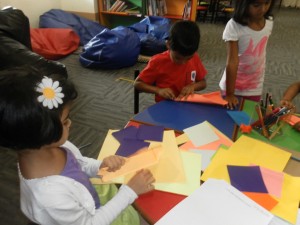This story misses the story. I don’t have access to the original research so I’m unsure as to whether the reporter is spinning an oft-told, irresponsible tale — “Kids these days are lazy and stupid!” — or the investigators employed an inadequate data collection tool.
Here’s what happened: The UK’s National Literacy Trust asked 18,000 seven- to 16-year-olds about their out-of-school reading habits. The article basically argued that children are not reading very much, and concluded with the British secretary of education’s opinion that children need to read more books — specifically, 50 per year.
I like books. I think they’re neat. But they’re not the only “game” in town.
Offering literacy experiences alongside books are: newspapers, magazines, blogs, forums, corporate websites, ads, social media profiles, games, TV, mainstream films, indy films, amateur films, radio, podcasts, comics, manga, fan fiction, ebooks, SMS texts, etc, etc, etc. Arguably, the sheer amount of text — and texts — in young people’s environment has exploded. So too has the amount of time they spend doing literacy: decoding, meaning making, and creating. We need to value the reading of multiple texts, for each has its own nature, and engaging in the experience of reading these texts has merit, both practical and theoretical.
According to the article:
“The research also found that the older the children are, the less likely they are to read. The 14- to 16-year-olds were 11 times more likely than the seven- to 11-year-olds to say they had not read a book in the last month.
Half said they read emails and websites at least once a month. Only just over a quarter – 27% – flick through comics.”
I take issue with the ambiguities and hidden assumptions here. Are older kids really less likely to READ, or just to read the products enumerated by the researchers? Are they less likely to read YouTube videos, Facebook profiles, or text messages? Are they less likely to read school-related non-fiction, such as textbooks or online sources (whose credibility may or may not be sterling (another issue entirely))? I think not. In these domains, older children’s participation dwarfs that of younger children’s. And while the older kids reported reading fewer books, it is entirely possible that, in terms of word count or cognitive challenge, they read the equivalent (or more!) via other platforms. It is also possible that these older kids, hoping to seem cool, under-reported their book-reading; the opposite is also possible, that the younger kids, eager to please/impress the researchers, over-reported their book-reading. Even without conscious manipulation, the accuracy of monthly estimations is poor for any demographic — people are just bad at remembering. For seven to 16-year-olds, you’ve got to figure that they’re even worse.
As for emails vs. websites vs. comics — who cares? Only a few decades ago, children’s comic book reading inspired moral panics. And now its (purported) diminution is also alarming? Which one is it? And is it even occurring at all? When the researchers say “comics,” do the kids understand this to mean online and offline, professional and amateur, anime, manga, and graphic novel? As for websites — what does it even mean to read a website? What kind of website? The language is too imprecise to even take on. Finally, emails. Many youths report that emails are seldom sent among their cohort, just as senior citizens claim low rates of text messaging amongst their peers. So, does this “low” (compared to what?) figure of email reading merely reflect the modest number of emails circulated? What is the value of this context-less data?
I know this much is true: To overlook multiple texts and the role they play in young people’s lives, and then conclude that children aren’t reading, is intellectually irresponsible. To fail to support children’s literacy skills around these texts is professionally irresponsible.
Our task is twofold, “local” and “global.” First, readers of all stripes should grapple together with the unique affordances of each text/literacy experience, helping one another to become savvier vis-a-vis specific sites. Some sample considerations: “Here’s what you should consider when you read a Wikipedia post.” “What does this podcast’s very existence tell us about its author?” “What do you know about the anime hero’s world by looking at the art in the background?”
Second, readers (and those who seek to teach and assess them) should focus on the underlying, universal skills required and developed by engaging with texts, such as: comprehending, synthesizing, and responding. They should also seize upon the perspective-taking that naturally occurs when readers connect with stories/storytellers, and help readers to improve their proficiency therein. Better ability to perspective-take will not only enrich individuals’ enjoyment of literature, but it will boost their efficacy as communicators and their capacity for sensitive social negotiation.
As the tide of texts surges, I don’t want to lose the book baby in all of this bathwater. But neither do I want to zero in on the baby and ignore the fact that she’s swimming in a sea of possibility…




